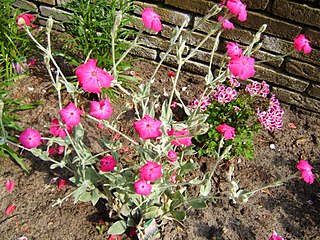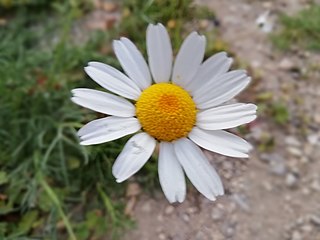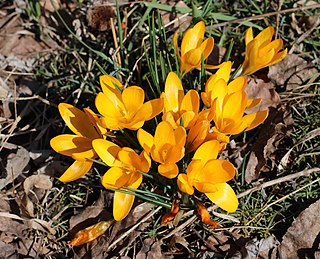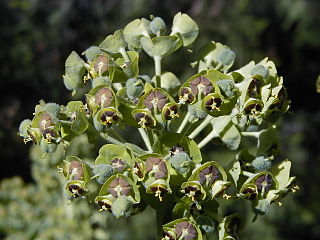
Begonia is a genus of perennial flowering plants in the family Begoniaceae. The genus contains more than 2,000 different plant species. The Begonias are native to moist subtropical and tropical climates. Some species are commonly grown indoors as ornamental houseplants in cooler climates. In cooler climates some species are cultivated outside in summertime for their bright colorful flowers, which have sepals but no petals.

Helianthemum, known as rock rose, sunrose, rushrose, or frostweed, is a genus of about 110 species of flowering plants in the family Cistaceae. They are widely distributed throughout the Northern Hemisphere, especially in the Mediterranean.

Molinia caerulea, known by the common name purple moor-grass, is a species of grass that is native to Europe, west Asia, and north Africa. It grows in locations from the lowlands up to 2,300 m (7,546 ft) in the Alps. Like most grasses, it grows best in acid soils, ideally pH values of between 3.5 and 5, however, it can continue to live under more extreme conditions, sometimes to as low as 2. It is common on moist heathland, bogs and moorland throughout Britain and Ireland. Introduced populations exist in northeastern and northwestern North America.

Armeria maritima, the thrift, sea thrift or sea pink, is a species of flowering plant in the family Plumbaginaceae. It is a compact evergreen perennial which grows in low clumps and sends up long stems that support globes of bright pink flowers. In some cases purple, white or red flowers also occur. It is a popular garden flower and has been distributed worldwide as a garden and cut flower. It does well in gardens designed as xeriscapes or rock gardens. The Latin specific epithet maritima means pertaining to the sea or coastal.

Deschampsia cespitosa, commonly known as tufted hairgrass or tussock grass, is a perennial tufted plant in the grass family Poaceae. Distribution of this species is widespread including the eastern and western coasts of North America, parts of South America, Eurasia and Australia.

Dicentra formosa is a flowering plant with fern-like leaves and an inflorescence of drooping pink, purple, yellow or cream flowers native to the Pacific Coast of North America.

Jacobaea maritima, commonly known as silver ragwort, is a perennial plant species in the genus Jacobaea in the family Asteraceae, native to the Mediterranean region. It was formerly placed in the genus Senecio, and is still widely referred to as Senecio cineraria; see the list of synonyms (right) for other names.

Silene coronaria, the rose campion, is a species of flowering plant in the family Caryophyllaceae, native to Eurasia. Other common names include dusty miller, mullein-pink and bloody William. In the United Kingdom it is still widely referenced under its synonym Lychnis coronaria.

Wallisia cyanea, or pink quill, is a species of plant of the genus Wallisia in the bromeliad family, native to the rainforests of Ecuador. An epiphytic perennial growing to 50 cm (20 in) high by 50 cm (20 in) wide, it has stemless rosettes of thin, recurved leaves and paddle-shaped spikes of 20 pink bracts with violet flowers, in spring and autumn.
Dusty Miller may refer to:

Centaurea gymnocarpa, also known as Capraian cornflower or centaury of Capraia, is a species of flowering plant in the family Asteraceae. It is a rare species endemic to Italy found only on Capraia, a small island located in the Tuscan Archipelago, with the species being distributed across 8 subpopulations on the island's surface. Its natural habitats are Mediterranean-type shrubby vegetation and rocky areas, colonizing in the cracks and fissures of cliffs.

Psephellus dealbatus, the Persian cornflower or whitewash cornflower, is a species of Psephellus native to the Caucasus Mountains and Turkey. It is widely cultivated as an ornamental perennial.

Argyranthemum frutescens, known as Paris daisy, marguerite or marguerite daisy, is a perennial plant known for its flowers. It is native to the Canary Islands. Hybrids derived from this species are widely cultivated as ornamental plants in private gardens and public parks in many countries, and have naturalized in Italy and southern California. There are many cultivars, but the most common has white petals.

Crocus flavus, known as yellow crocus, Dutch yellow crocus or snow crocus, is a species of flowering plant in the genus Crocus of the family Iridaceae. It grows wild on the slopes of Greece, former Yugoslavia, Bulgaria, Romania and northwestern Turkey, with fragrant bright orange-yellow flowers. It is a small crocus (5–6 cm, despite the names of some cultivars, compared to the giant Dutch crocuses. Its cultivars are used as ornamental plants.

Leucanthemella is a genus of flowering plants in the sunflower/daisy family Asteraceae.

Euphorbia characias, the Mediterranean spurge or Albanian spurge, is a species of flowering plant in the family Euphorbiaceae typical of the Mediterranean vegetation. It is an upright, compact evergreen shrub growing to 1.2 m tall and wide.

Scilla bifolia, the alpine squill or two-leaf squill, is a herbaceous perennial plant growing from an underground bulb, belonging to the genus Scilla of the family Asparagaceae.

Arabis caucasica is a species of flowering plant in the mustard family (Brassicaceae) known by the common names garden arabis, mountain rock cress or Caucasian rockcress.

Galanthus plicatus, the pleated snowdrop, is a species of flowering plant in the family Amaryllidaceae, native to eastern Europe and western Asia. It is a spring flowering bulbous herbaceous perennial.

Garden marguerites, also known as marguerite daisies, are cultivars of plants in the subtribe Glebionidinae of the family Asteraceae, the great majority being hybrids created in cultivation. One of the genera belonging to the subtribe, Argyranthemum, was introduced into cultivation from the Canary Islands in the 18th century, and modern cultivars are mostly sold and grown under the genus name Argyranthemum or the species name Argyranthemum frutescens, although many are actually intergeneric hybrids. The first such hybrids involved species now placed in the genus Glebionis, but other crosses within the subtribe are known. Breeding has aimed at introducing flower heads in varied colours and shapes while retaining the shrubby habit of Argyranthemum. Garden marguerites are used as summer bedding or grown in containers. Most are only half-hardy. They can be trained into shapes such as pyramids or grown as standards.



















